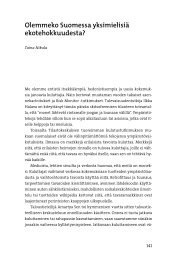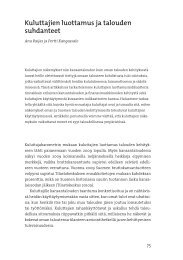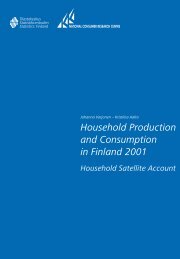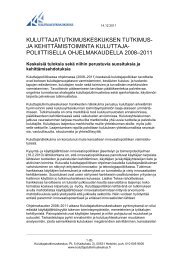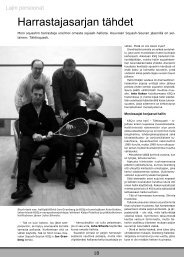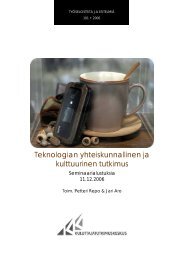Household Production and Consumption in Finland 2001
Household Production and Consumption in Finland 2001
Household Production and Consumption in Finland 2001
Create successful ePaper yourself
Turn your PDF publications into a flip-book with our unique Google optimized e-Paper software.
8.3 Development needs<br />
The data produced by the <strong>Household</strong> Satellite Account constitute an extensive<br />
cross-sectional material <strong>and</strong> as such provide a good picture of the extent of<br />
household production. As is the case all economic statistics, here also it is<br />
important to know the direction <strong>and</strong> pace of development. Time series are<br />
crucial to systematic monitor<strong>in</strong>g the development of household production<br />
<strong>and</strong> its relationship to the rest of the national economy. It would be<br />
particularly important to monitor the development of households’ own<br />
production versus the use of purchased services <strong>in</strong> different pr<strong>in</strong>cipal<br />
functions, because shifts <strong>in</strong> production have a major impact on bus<strong>in</strong>ess <strong>and</strong><br />
<strong>in</strong>dustry, employment <strong>and</strong> services provided by the public sector. Age<strong>in</strong>g<br />
people who live <strong>in</strong> the community need care, which is now ma<strong>in</strong>ly produced<br />
by spouses or other relatives. Population age<strong>in</strong>g may well <strong>in</strong>crease the dem<strong>and</strong><br />
for purchased services. Shopp<strong>in</strong>g <strong>and</strong> services as well as travel <strong>and</strong> transport<br />
related to unpaid work seem to be on the <strong>in</strong>crease. These developments<br />
describe the impacts of the social structure <strong>and</strong> <strong>in</strong>frastructure on households.<br />
The aim now is to compile household satellite accounts on a regular basis at<br />
five-year <strong>in</strong>tervals or more often, for example whenever a household budget<br />
survey produces new data on changes <strong>in</strong> consumption <strong>and</strong> whenever new time<br />
use studies are conducted. S<strong>in</strong>ce habits of time use are relatively slow to<br />
change, <strong>and</strong> s<strong>in</strong>ce time use studies are carried out less frequently than<br />
household budget surveys, it might be possible <strong>in</strong> the <strong>in</strong>terim to use earlier<br />
data on time use that are adjusted accord<strong>in</strong>g to changes <strong>in</strong> household structure<br />
<strong>and</strong> to update the consumption data.<br />
Some revisions <strong>in</strong> the classifications used <strong>in</strong> the source materials would be<br />
helpful. First, it would be useful to classify the use of market <strong>and</strong> public<br />
services substitut<strong>in</strong>g household production by pr<strong>in</strong>cipal function (food, care,<br />
laundry, clean<strong>in</strong>g <strong>and</strong> repair services). Use of these services was still at a low<br />
level <strong>in</strong> <strong>2001</strong> but it is now set to <strong>in</strong>crease as a result of new tax deduction rules<br />
<strong>and</strong> changes <strong>in</strong> attitudes towards us<strong>in</strong>g market services.<br />
Furthermore, it would be useful to be able more fully to <strong>in</strong>clude public<br />
sector taxes <strong>and</strong> subsidies on household production. The present calculations<br />
have taken account of home care allowances <strong>and</strong> parents’ allowances as well as<br />
certa<strong>in</strong> taxes (real estate tax, vehicle <strong>and</strong> dog tax, fish<strong>in</strong>g licence fees).<br />
However, services such as childcare <strong>and</strong> the care of the frail elderly are heavily<br />
subsidised from the public purse. Liv<strong>in</strong>g <strong>in</strong> rented accommodation is<br />
supported by a hous<strong>in</strong>g allowance <strong>and</strong> owner-occupied accommodation by tax<br />
deductions. Conduct<strong>in</strong>g separate studies to determ<strong>in</strong>e the shares of these<br />
subsidies <strong>and</strong> their impacts on household production might be a good way to<br />
clarify the role of public sector on households’ economic behaviour.<br />
In the future, we also wish to be able to use output method to determ<strong>in</strong>e<br />
the value of production. That would provide important comparative data both<br />
on value added <strong>and</strong> on the competitiveness of household production relative to<br />
market production. In the present calculation labour was valued on the basis of<br />
the gross wage of housekeeper (ISCO 51331). Whatever the choice of wage,<br />
National Consumer Research Centre Statistics F<strong>in</strong>l<strong>and</strong> 73




